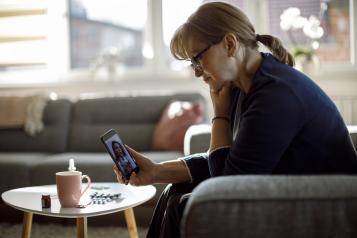Small Changes Could Improve Cervical Screening Uptake

In our latest Report about Cervical Screening experiences in Hertfordshire, 94% of respondents said they had attended one or more cervical screening appointments, although a quarter told us they were not confident about attending further screenings even though they understood the importance of getting checked.
Cervical screenings (previously known as smear tests or pap smears) check cervix health to help prevent cervical cancer from developing. A small sample of cells from the cervix are tested for high-risk types of Human Papillomavirus (HPV) that can lead to cervical cancer if left untreated. All women and people with a cervix aged 25-64 are invited to be screened regularly (either every 3 or every 5 years).
In 2008 the HPV vaccine programme began in England to help protect people against some forms of HPV and, as a result, cervical cancer. Having the vaccine does not prevent all types of HPV, so cervical screening is still recommended.
Why did we do this research?
According to NHS England, uptake for cervical screening in Hertfordshire is about 70 per cent. The Hertfordshire and West Essex Integrated Care Board (ICB) Primary Care Board asked Healthwatch Hertfordshire to investigate local cervical screening experiences.
“We are always grateful to hear experiences of people using local services. The feedback helps us identify areas of improvement, areas of structural change as well as understand where we need to develop and commission key services to match and reflect the needs of our community.”
Between August and October 2023, we heard from 233 women* in our research, which aimed to:
- Explore the uptake of cervical screenings and whether people feel well-informed about cervical screenings
- Understand people’s experiences of having a cervical screening
- Identify the barriers people may face in accessing a cervical screening
* Our survey was directed at women and people with a cervix living in Hertfordshire, whether or not they had ever attended a cervical screening. We only had those who identify as a woman filling in this survey, so the term ‘woman’ has been used throughout.
What did women tell us?
Reassuringly, 97% of respondents had received an invitation to attend a cervical screening and knew what the test was and why they should have it. Only 6% of respondents had never attended a cervical screening appointment and most of these were women aged 25-34.
Our research showed:
- 73% of respondents described the care they received at their cervical screening as either good/very good, 19% said it was fine and 9% said it was bad/very bad
- For those who had a positive experience, most said it was because the clinician was kind, sympathetic, reassuring, efficient and treated them with respect and dignity.
- Some who said their experience was unpleasant and/or painful acknowledged it was simply due to the nature of the procedure, rather than any fault of the clinician.
- For those who said their care was bad/very bad, this was mostly due to the clinician performing the cervical screening being insensitive, lacking compassion, rushing or lack of training.
- Several respondents also said there should be more training about the menopause and the impact it can have on screenings – making them painful.
- Unfortunately, some respondents said their experience was so poor they were reluctant to attend a cervical screening again. A quarter told us they were not confident about attending further screenings even though they understood the importance of getting checked.
- Concerningly, Black respondents were far less likely to feel confident about attending at just 50% as well as women with less disposable income.
- A major barrier to getting screening was lack of available appointments, long waiting times on the phone and not being able to book a cervical screening online.
- Several respondents were keen to access self-testing/home-testing kits. This has been trialled by the NHS in some areas, but not in Hertfordshire.
- Another common theme was extending the lower and upper age limit restrictions of being invited for a cervical screening – starting younger and continuing later.
- 85% of respondents said they were automatically told their cervical screening test results. Some said results could have been delivered more sensitively and they did not receive an adequate explanation or reassurance following a positive HPV result. They also did not always get enough information or advice about what happens following a positive HPV result, again often causing distress and anxiety.
What happens now?
Cervical screening is an intimate procedure, so it is important that patients feel supported and as safe as possible. Patients should be able to book their appointment in a way that suits them, so they can choose a convenient time and place. They also should be made aware of different accommodations that might help them feel more confident and comfortable during the appointment.
“We would like to thank everyone who took time to respond and want to let people know that we are always working to improve services. We have recently trialled a screening project in Hertsmere where people who have missed their latest cervical screening were proactively phoned and offered to make an appointment on the spot. So far outcomes have been positive. We also have new toolkits for practices to support them with advice and messaging scripts. It also gives top tips for making adjustments if these are needed. We will review all these recommendations and keep Healthwatch informed of progress.”
In our Report, we have recommended:
- Invitations to cervical screenings be provided in a range of formats, including letters, text messages and emails and enable cervical screenings to be booked online.
- Provide appointments for cervical screenings outside of typical working hours, including evenings and weekends. This could also include the provision of walk-in clinics.
- Ensure women receive enough information about cervical screenings and why they are important, even if you have been vaccinated.
- Consider targeted engagement with ethnically diverse communities, younger women and those with less disposable income to improve confidence and attendance.
- Support and promote a trial or roll-out of self-sampling at-home HPV tests.
- Ensure effective training and awareness for practitioners, particularly about the impact menopause can have on this procedure.
- Consider providing double appointments to women having their first screening or those concerned about pain or anxiety after a previous screening. This would ensure time for reassurance and information.
- Advise reception staff to mention available accommodations at the point of booking cervical screenings. These might include - requesting a female practitioner, a chaperone in the room, a longer/double appointment, pessaries or creams to help with vaginal dryness, a smaller speculum (the tool that is inserted in order to be able to see the cervix).
Offering such accommodations can help address some of the barriers patients face, yet many are not aware they can ask for such support and adjustments.
Downloads
Read the full Report here:


